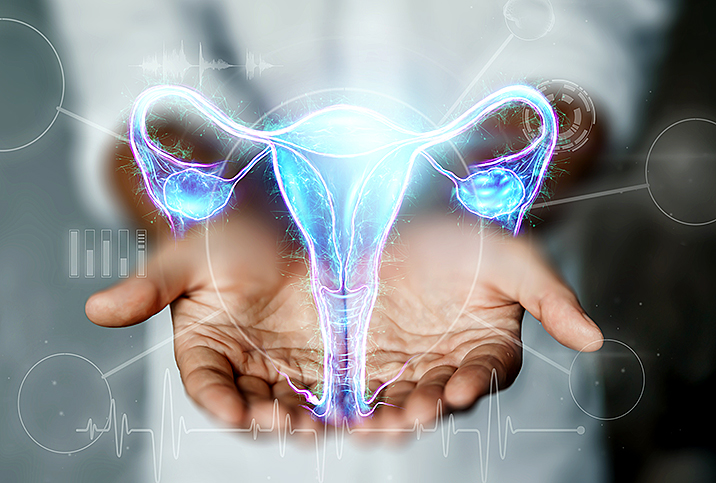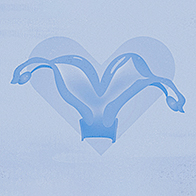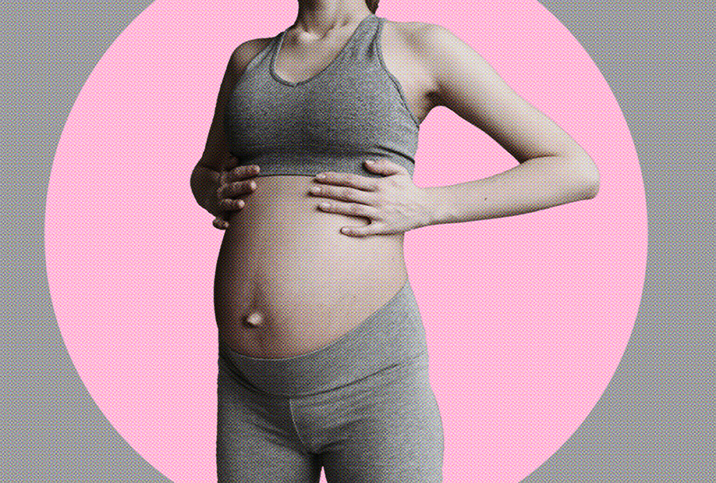A Guide to the Complex Layers of Your Uterine Lining

Menstruators typically hear about their endometrium when being diagnosed with endometriosis. It's easy to pay attention to our body when it's not behaving as desired, but when it's working as normal—we have little reason to delve deeper into the mechanics.
The endometrium is an important part of the uterus, which plays a major role in pregnancy and menstruation. And when it misbehaves, serious complications can occur. So what exactly is the endometrium when it's not bothering its owner? And how does the endometrium fit within the complex structure of your uterus?
The architecture of the uterus
Your uterus is quite complex, made up of layers within layers of tissue that function to keep your reproductive system working properly. The top layer is called the serosa, smooth outer tissue that covers the uterus and allows the organ to move easily within the pelvis as needed.
The middle layer of the uterine wall is the myometrium, and beneath that is the endometrium. Each layer of the uterus is made up of its own individual layers.
The endometrium
"The endometrium is divided into three layers—the stratum compactum, stratum spongiosum and the stratum basalis. The [former two] make up the stratum functionalis, which becomes vascularized, expands, and sloughs off, while the basalis remains constant," said Kecia Gaither, M.D., an OB-GYN, director of Perinatal Services at NYC Health + Hospitals.
The stratum basalis is easy to overlook since it's not what we're most tangibly familiar with. Since the stratum functionalis is bled out, it feels much more real. However, the stratum basalis is an essential base in which uterine glands and stromal tissue (tissue providing shape and connectivity to organs) feed the growth of the superficial stratum functionalis. That stratum functionalis, of course, is what is then expelled on a near-monthly basis in menstruation.
What's most relevant for the average person to understand is that "top-most" refers to a layers' proximity to a fetus or unfertilized eggs. The top-most layers of the endometrium that are constantly in flux are actually those deepest in the uterus.
The stratum spongiosum is "the fluffy bedding tissue that grows during the menstrual cycle in response to preparing the uterus for pregnancy," said Betsy Greenleaf, D.O., the first board-certified female urogynecologist in the United States. The stratum compactum is "a thin layer of tissue that sits on top" of the stratum spongiosum and is "closest to the lining of the cavity."
The myometrium
If the stratum spongiosum is a fetus' nutrient-rich bed and the stratum compactum is the sheets to the bed, then the actual mattress would be the myometrium. A complex and powerful network of muscles, the myometrium propels birthing and menstrual contractions.
"Anything having to do with the womb is referred to as the 'metrium,'" Greenleaf explained. "It is the myometrium (myo meaning muscle) that is responsible for contractions during childbirth."
According to Greenleaf, the muscle then continues to contract during your period to push out the unused endometrium. "We always have an inner lining of the uterus [to] prepare a nest for a pregnancy," she said. "If you don't get pregnant that month, then all that blood and tissue in the nest, or thickened endometrium, is not needed."
"The myometrium has three layers—the outer layer of longitudinal smooth muscles, the middle composed of crisscrossing muscle fibers, and inner circular fibers," Gaither added.
Between the myometrium and the endometrium, we've racked up a total of six different layers to the uterine lining, two of which are disposed of with every period and four of which remain constant. That said, even the myometrium's three layers are understood less as clearly defined tiers and more as interlocking muscles—think of an airtight basket that uses its tight weaving to propel out its contents.
The uterine lining thickness matters
According to Greenleaf, the thickness of your uterine lining can impact fertility. "If the lining of the uterus is too thin, it cannot support a pregnancy," she said. It is possible for this tissue to thin "due to hormon[al] imbalance or even as a surgical complication from a vigorous dilation."
An overly thick uterine lining, however, can also have negative health ramifications. "Women with excess estrogen can develop a thickening of the endometrium that can cause bleeding issues and at an extreme can lead to endometrial cancer," Greenleaf said. "Bleeding from a thickened uterus tends to be bright red and thick if it is newly shed tissue to dark brown and chunky if it is old tissue that has been within the uterus for some time."
Where it grows matters, too
Endometriosis (likely, the reason why you've heard of the endometrium) is a condition in which the uterine lining tissue grows outside of the uterus and instead on the ovaries and fallopian tubes.
Lesser known than endometriosis is adenomyosis. "Adenomyosis is like endometriosis, where the lining of the uterus is growing someplace outside of the uterine cavity, " Greenleaf said.
"The mechanism of adenomyosis is not well understood, but the endometrial lining actually gets within the muscle layer of the uterus and grows within the myometrium, [whereas] pain occurs during endometriosis because those endometrial cells that are growing outside of the uterus have no place to go and they bleed internally," Greenleaf explained. "Blood within the abdominal cavity is an extreme irritant."
Can you improve your uterine lining?
As is the case with so many bodily concerns, the best prevention is a good diet. "Research has noted certain supplements/nutrients are helpful for thickening the uterine lining—vitamin E, L-arginine, omega-3, consumption of whole grains," Gaither said.
Providing a good blood flow to your uterus can also thicken the uterine lining, so regular, moderate exercise is advised. Limit activities that may restrict blood flow, such as drinking excessive amounts of coffee and smoking.
Besides eating well, exercising and avoiding stress to a realistic degree, the best plan is to remain in communication with your healthcare provider about any shifts in your body. The red flags signaling an issue with your endometrium are quite often literally red.
Greenleaf advises to see a doctor "if you [have] irregular bleeding during times other than your period, extremely heavy bleeding during [your] period, bleeding that fills more than a tampon or pad an hour, increased pain in [the] lower abdomen, fever [and] foul odor with bleeding."




















